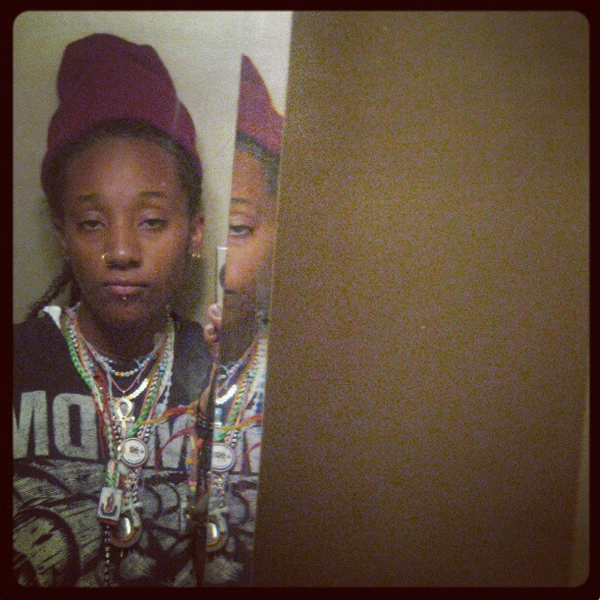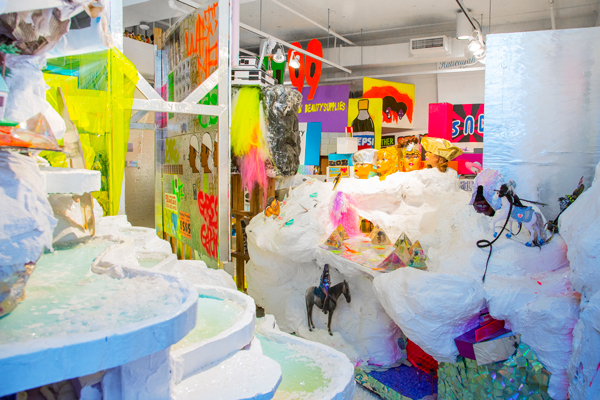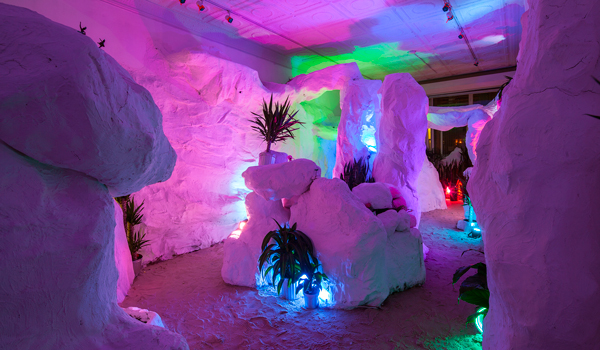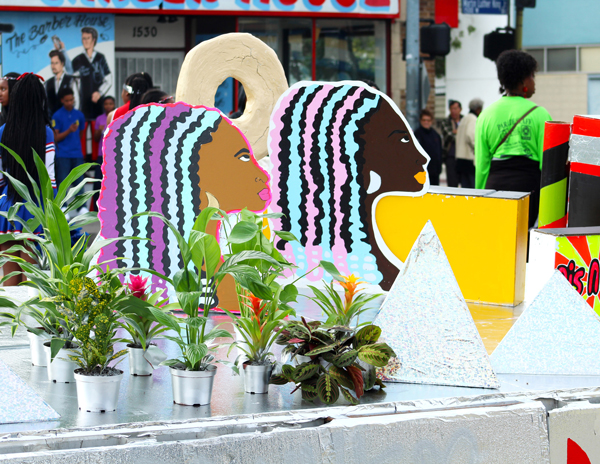When I first saw Lauren Halsey’s work-in-progress during her residency at the Studio Museum in Harlem, I was stupefied. The installation was genuinely a new experience, challenging my notion of visual and spatial aesthetics. It was exhilarating and puzzling, but familiar. Two years later I saw the float she made for the Martin Luther King Day parade in Los Angeles and I knew this was an artist I had to know more about. We met on a hot August day, where we sat under the cool canopy of an oak tree at the Memorial Branch Library and had a conversation.

Halsey self-portrait
Todd Gray: After reading your manifesto on the Rema Hort Mann Foundation website I was intrigued about your architecturally-grounded, community-based, process-oriented work. Did you receive much support in art school?
Lauren Halsey: My father always instilled in us the value of community. I was interested in architecture and building spaces around community. I had no idea why; it was visceral. I was very interested in Sun Ra at the time and proposing this heaven, or this other world, and actualizing that in the form of structures. I was making community blueprints, remixing nostalgia and memory into Afro-futurism.
Then I started thinking about access to space and contextualizing spaces I was building in the neighborhood and the importance of wanting to build FUBU (For Us By Us), this black space in the neighborhood for the neighborhood, and I realized the proposals that we were building in architecture school were as far from that as possible, and I wasn’t interested in that discourse. I was also inspired by a lot of fantasy architecture that Superstudio was doing in the ’70s, really beautiful ways of combating the mess of the world, fun architecture. They obviously never got built, so that was my lesson from that.

Kingdom Splurge (2.4.6.14), Yale University, photo by Fumi Ishino
That led you to CalArts, which eventually led you to Yale, and I’m assuming you worked with Charles Gaines [at CalArts].
Charles Gaines, Douglas Kearney, Sam Durant, Connie Hatch, just everybody… Anoka Faruqee, they were all so super-supportive and patient and generous. I did a lot of reading. CalArts wasn’t as hands-on as Yale, as far as my practice was concerned. I spent a lot of time developing and writing down my ideas. Charles hired me as his assistant. Looking back, those times were extremely formative, in really, really beautiful ways. So I’m forever grateful to CalArts. Then I got to Yale [for a graduate degree] and I decided I had been doing the blueprints for years, and I wanted to get out of Photoshop and get my hands into it, literally, and expand them into actual physical iterations.
How do you maintain inspiration that your work is having effect? You’re working in an area that’s pretty uncharted, and you want to inspire change.
I’m very inspired by the community and watching my neighborhood be resilient to the mess, the takeover gentrification. So I was able to present a float in the Martin Luther King Day Parade. That was my first public work. The issue for my practice has been that I’ve been proposing these alternatives for the neighborhood, outside of it.

Kingdom Splurge (4), Recess, New York. Photo Credit: Nick Johnson
In the white cube?
Yeah, or just an audience that’s just not, you know… As far as inspiration it’s just reaching the level to get to them. That’s where I get all my energy from. In LA, I’m on the bus, talking. At Yale or in my studio in CalArts, no one wants to drive up the Interstate 5, unless they’re going to Six Flags, and I get that. Now it’s about remixing the work back into its original context.
How did you navigate the futuristic aspect, the funk, the linkage to pop culture and the fantastic? How do you translate that into a dialogue with the community that’s meaningful and not merely archi-tainment?
My interest in funk and the aesthetics of funk that I love—Parliament/ Funkadelic is what I’m thinking about—are the links I see in the community, like maximalism and the aesthetics of how space is organized, being on the one with oneself, the community or a band. My process correlates to the rhythm of what people are already doing in the neighborhood; that’s the parallel I see with funk: Making monuments out of the poetics of the neighborhood that me and my friends are obsessed with, embedding my own fictions in them, and animating them and actually believing in them is meaningful, and people must pick up on that energy. I haven’t yet tested these things out in the neighborhood.

Kingdom Splurge (3.7.15.15), The Studio Museum in Harlem, NY, photo by King Texas
So you’re in the laboratory phase?
Yeah, but I had a beautiful breakthrough with the float. Like I saw the dream, the magic and wonder in children’s and our elders’ eyes, and also at the Studio Museum in Harlem. Working on 125th Street, making friends with people, lounging around, talking to street vendors on the block and bringing them into my studio and literally putting them into my work was meaningful to them and to me, giving us both agency in the museum space.
How do you position your work in the last couple of years with Trumpism and Black Lives Matter?
The hieroglyphs I made at the Studio Museum were in conversation with that on a more local scale. My cousin got killed around the corner from our house, the Grim Sleeper ended up living on our block. Using the hieroglyphs as a document tableau of all of the pain and trauma that’s been swept under the rug… one more thing that the LAPD and local news, people outside of the neighborhood were missing on purpose. I wanted to honor that moment and empower people that we’ve lost, raise questions that might empower the neighborhood. Being in Harlem I felt that I was being affirmed every day by people on the block, friends, strangers. That took a lot out of me, like I was depleted emotionally after, but that’s fine, we all live with it. So I’m not saying I’m special.
Yes but to enter that space, the space of trauma.
But black trauma is real, we all have it.
But we segment it, compartmentalize it.
Yeah, that’s true. So I did the float, this beautiful thing to empower everyone.

Detail of float
I did this project at Recess, a space in SoHo, where I wanted to make work that wasn’t about trauma and pain, that wasn’t about people who got murdered. It was about the absence of mess and pain. It was a healing space where you’re able to feel safe, to feel beautiful, calm and chill.
Moving through oppressive architecture and space—I think it’s very powerful—the idea of building one’s space and living in it, embodying and moving through it and building it for one’s community and generating community as opposed to relying on the oppressive space-making that is forced on us, like schools that look like prisons or jails. Or going for Chinese food and the bulletproof glass is like 50-million- inches thick—you know, all these situations that make me feel like I’m a threat.
Something I work with is how to open up a dialogue with viewers who are not fluent in or familiar with visual art.
For me, the conversations start before I begin making the work, with people that inspire the work that are in the community—it always starts from there. As far as bringing people in, it starts with the idea, it’s not a separation between the subject and me making the work and then the presentation. It’s all one sentence or thing.
Your practice is so out of the boundaries of the traditional object-oriented art practice.
I spoke with Thelma [Golden] and Charles [Gaines] a lot about this, the importance of creating my own context and the power of having autonomy. And Thelma said this great thing—“You have autonomy when you become an expert.” So I’ve been working on becoming an expert.


